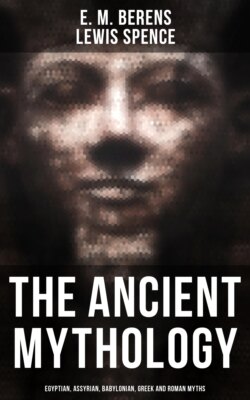Читать книгу The Ancient Mythology: Egyptian, Assyrian, Babylonian, Greek and Roman Myths - Lewis Spence - Страница 62
На сайте Литреса книга снята с продажи.
At the Gates of Aralu
ОглавлениеComing to the gate of Aralu, Ishtar assumes a menacing aspect, and threatens to break down the door and shatter its bolts and bars if she be not admitted straightway. The keeper of the gate endeavours to soothe the irate deity, and goes to announce her presence to Eresh-ki-gal (Allatu), the mistress of Hades. From his words it would appear that Ishtar has journeyed thither in search of the waters of life, wherewith to restore her husband Tammuz to life. Allatu receives the news of her sister's advent with a bitter tirade, but nevertheless instructs the keeper to admit her, which he proceeds to do.
Ishtar on entering the sombre domains is obliged to pass through seven gates, at each of which she is relieved of some article of dress or adornment (evidently in accordance with the ancient custom of Aralu), till at last she stands entirely unclad. At the first gate the keeper takes from her "the mighty crown of her head"; at the second her earrings are taken; at the third her necklace; at the fourth the ornaments of her breast; at the fifth her jewelled girdle; at the sixth her bracelets; and at the seventh the cincture of her body. The goddess does not part with these save under protest, but the keeper of the gate answers all her queries with the words: "Enter, O lady, it is the command of Allatu." The divine wayfarer at length appears before the goddess of the underworld, who shows her scant courtesy, bidding the plague-demon, Namtar, smite her from head to foot with disease—in her eyes, side, feet, heart, and head.
During the time that Ishtar is confined within the bounds of Aralu all fertility on the earth is suspended, both in the animal and vegetable kingdoms. Knowledge of this disastrous state of affairs is conveyed to the gods by their messenger, Pap-sukal, who first tells the story to Shamash, the sun-god. Shamash weeps as he bears the matter before Ea and Sin, gods of the earth and the moon respectively; but Ea, to remedy the sterility of the earth, creates a being called Ashushu-namir, whom he dispatches to the underworld to demand the release of Ishtar. Allatu is greatly enraged when the demand is made "in the name of the great gods," and curses Ashushu-namir with a terrible curse, condemning him to dwell in the darkness of a dungeon, with the garbage of the city for his food. Nevertheless she cannot resist the power of the conjuration, wherefore she bids Namtar, the plague-demon, release the Annunaki, or earth-spirits, and place them on a golden throne, and pour the waters of life over Ishtar. Namtar obeys; in the words of the poem he "smote the firmly-built palace, he shattered the threshold which bore up the stones of light, he bade the spirits of earth come forth, on a throne of gold did he seat them, over Ishtar he poured the waters of life and brought her along." Ishtar is then led through the seven gates of Arula, receiving at each the article of attire whereof she had there been deprived. Finally she emerges into the earth-world, which resumes its normal course. Then follow a few lines addressed to Ishtar, perhaps by the plague-demon or by the keeper of the gates. "If she (Allatu) hath not given thee that for which the ransom is paid her, return to her for Tammuz, the bridegroom of thy youth. Pour over him pure waters and precious oil. Put on him a purple robe, and a ring of crystal on his hand. Let Samkhat (the goddess of joy) enter the liver...." These lines indicate with sufficient clearness that Ishtar descended into Hades in order to obtain the waters of life and thus revive her bridegroom Tammuz. The poem does not relate whether or not her errand was successful, but we are left to conjecture that it was. There still remain a few lines of the poem, not, however, continuing the narrative, but forming a sort of epilogue, addressed, it may be, to the hearers of the tale. Mention is made in this portion of mourners, "wailing men and wailing women," of a funeral pyre and the burning of incense, evidently in honour of the god Tammuz.
